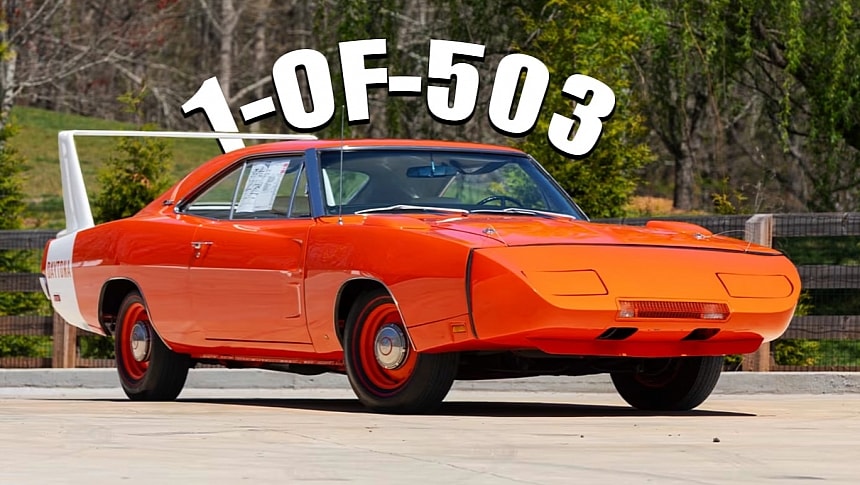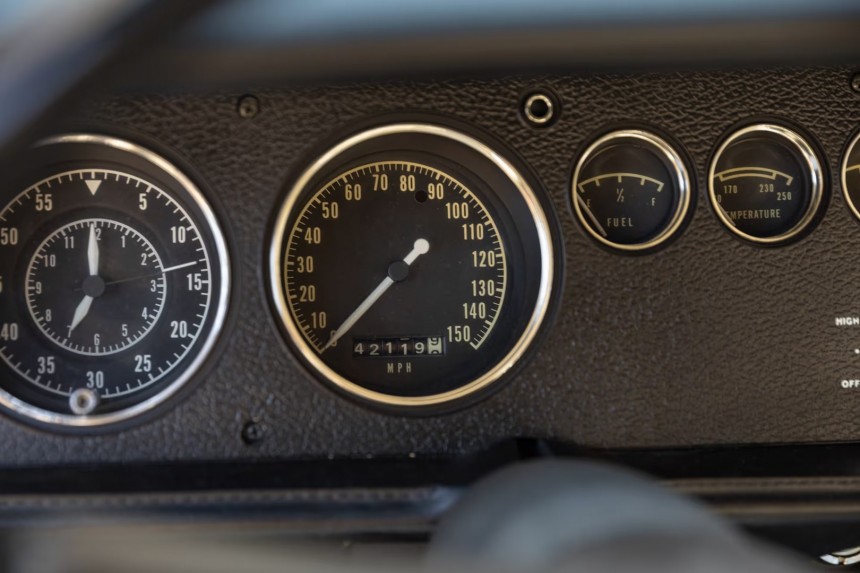For the right enthusiast, the words "1969 Dodge Charger Daytona" can sometimes bring joy, sorrow, or pride, while stirring up old memories. Only 503 units of the '69 model were ever built, and alongside the 1970 Plymouth Superbird, the Daytona is considered the most radical production model from the golden era of muscle cars. The winged warrior's nameplate carries not only an untarnished reputation, but also an immovable legacy. That's one of the many reasons our auctioned-off Mopar is truly special.
The 1969 Dodge Charger Daytona was sold as new at Manzi Dodge, Inc. in Lowell, Massachusetts. One of the best things about it is that it retains its original drivetrain, body, and interior, not to mention the factory color Hemi Orange, which contrasts superbly with the white wing. If you step inside, you'll probably find the white interior as charming as the exterior features. The color combo is very rare.
The numbers-matching 440-cubic-inch (7.2-liter) Magnum V8 engine can produce 375 hp or 380 ps. It has the A33 Track Pak option, meaning those 375 ponies end up at the rear wheels through its classic A833 New Process 4-speed manual gearbox. The 4-barrel Carter carburetor, Dana 60 differential with SureGrip, and 3.55 final gearing also help move things along. Because it was based on the Charger R/T version, it came with a heavy-duty suspension and brake system.
Of the 503 units made that year, 70 featured the optional 426-ci (7.0-liter) HEMI engine that produced 425 horsepower (431 ps). Like the 440 Magnum, this more powerful version also came in a 4-speed manual or a 3-speed automatic transmission system.
It weighs around 4,123 lbs. or 1,870 kilograms, and back in its heyday, this aero warrior could have gone from 0 to 60 mph in 5.6 seconds or from 0 to 62 mph in 5.9. It also could have completed the 1/4-mile in 14.2 seconds or an entire kilometer (0.62 miles) in 25.8 seconds. All these vary depending on a whole suite of factors, so don't take these numbers as gospel.
However, what we know for a fact is that back in the golden era, Buddy Baker got behind the wheel of a Daytona and reached 200.447 mph (322.58 kph) at the Talladega raceway, making this winged warrior the first NASCAR race-car to exceed the 200 mph barrier.
This 1-of-503 '69 Charger Daytona is a 6-figure car, and given its history, there's no denying the value of having one of these in your garage. The seller, Mecum Auctions, estimates it will end up somewhere between $375k and $425k. There have been exceptions that border on unique, like a 1969 Dodge HEMI Daytona with only 6,490 miles (10,384 km) on the odometer that sold for $1.3 million last January.
It would be interesting to see how much this sells for because 2024 is not quite a stellar year for buyers. Being such a rare item, owners won't risk damaging it, and they won't put a lot of miles on it, not to mention the scarcity and price of the spare parts.
The numbers-matching 440-cubic-inch (7.2-liter) Magnum V8 engine can produce 375 hp or 380 ps. It has the A33 Track Pak option, meaning those 375 ponies end up at the rear wheels through its classic A833 New Process 4-speed manual gearbox. The 4-barrel Carter carburetor, Dana 60 differential with SureGrip, and 3.55 final gearing also help move things along. Because it was based on the Charger R/T version, it came with a heavy-duty suspension and brake system.
Of the 503 units made that year, 70 featured the optional 426-ci (7.0-liter) HEMI engine that produced 425 horsepower (431 ps). Like the 440 Magnum, this more powerful version also came in a 4-speed manual or a 3-speed automatic transmission system.
However, what we know for a fact is that back in the golden era, Buddy Baker got behind the wheel of a Daytona and reached 200.447 mph (322.58 kph) at the Talladega raceway, making this winged warrior the first NASCAR race-car to exceed the 200 mph barrier.
This 1-of-503 '69 Charger Daytona is a 6-figure car, and given its history, there's no denying the value of having one of these in your garage. The seller, Mecum Auctions, estimates it will end up somewhere between $375k and $425k. There have been exceptions that border on unique, like a 1969 Dodge HEMI Daytona with only 6,490 miles (10,384 km) on the odometer that sold for $1.3 million last January.
It would be interesting to see how much this sells for because 2024 is not quite a stellar year for buyers. Being such a rare item, owners won't risk damaging it, and they won't put a lot of miles on it, not to mention the scarcity and price of the spare parts.


































